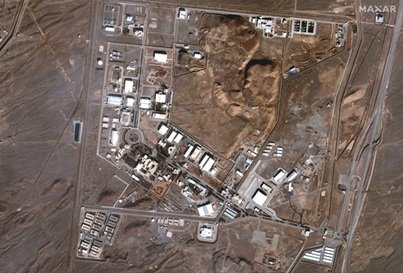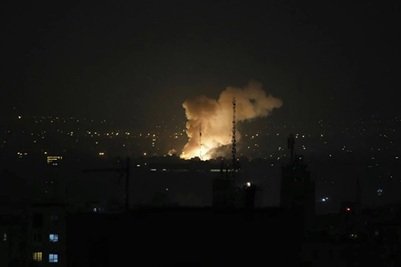By Courtney Kube, Mosheh Gains and Chantal Da Silva
The Israeli military launched a massive attack on Iran on Friday in a dramatic escalation of their long-running conflict that drew a retaliatory missile assault from Tehran and raised the risk of another war in the Middle East.
The Israeli strikes took out a significant swath of Iran’s top military leaders and senior scientists, as Israel unleashed more than 200 fighter jets across roughly 100 targets.They were aimed at Iran’s main enrichment facility and targets associated with the country’s ballistic missile program, Israeli Prime Minister Benjamin Netanyahu said.
In a firm response Friday evening local time, Iran launched missiles toward Israel, the nation’s defense forces said, prompting its highly sophisticated defense systems to “intercept the threat.”
Heavy smoke appeared in the night sky over Tel Aviv as incoming rockets from Iran descended on the city, with many intercepted by Israel’s missile defense systems. Before the retaliatory attack began, the Israel Defense Forces directed residents across the country to remain close to protected spaces, minimize movement in public areas and avoid public gatherings.
Police officers and bomb disposal experts responded to reports of fallen projectile debris, according to the Israeli Police, which advised people to report “suspicious findings” to an emergency hotline.

facility, south of the capital, Tehran. Maxar Technologies / AFP
Israel’s emergency service, Magen David Adom, said it was providing medical treatment to 34 injured people following a rocket strike in Israel’s central region.
The Israeli paramedic organization also said it was providing treatment and evacuating at least 21 people after a strike south of Tel Aviv.
Iran later launched a fresh wave of missiles in the early hours of Saturday morning local time, Israel Defense Forces said.
A Tel Aviv hospital treated seven people with injuries following the early morning attack, The Associated Press reported.
Israel’s strikes have killed 78 people so far, including senior military officials, and injured 320 people, according to Iranian ambassador to the United Nations Ali Bahreini. Residential buildings were among the structures damaged in Tehran.
Loud explosions in Iran were heard in the northern part of the capital on Friday night, while state media reported attacks in Qom, located south of Tehran and a holy city for Shia Muslims. Fars reported on X that explosions could be heard in the area of the heavily fortified nuclear site of Fordow, which is located deep underground near Qom.
Supreme Leader Ayatollah Ali Khamenei swiftly vowed retaliation, telling his nation in a televised address Friday evening local time that Israel would be punished.
Air defense systems were activated in central Tehran, home to Khamenei’s compound and presidential office, reported the Iranian semiofficial Mehr news agency.
Soon after the strikes, Iran launched more than 100 drones toward Israel, Israeli Brig. Gen. Effie Defrin said. The Israel Defense Forces said it was attacking missile launchers and unmanned aerial vehicles launched from Iran, and a military spokesman said on X that strikes were conducted on the nuclear plant in Isfahan in central Iran.
Iran has long denied that it is seeking to develop nuclear weapons.
The United States, which had been publicly urging Israel to hold off on such an attack as the Trump administration continues talks with Tehran on its rapidly advancing nuclear program, said it was not involved in the strikes on Iran and was not assisting with the attacks.
But three U.S. officials told NBC News later Friday that the U.S. is assisting in shooting down Iranian missiles and projectiles targeting Israel. The Pentagon moved a number of military assets into the region in recent days, including Navy destroyers to be positioned off the Israeli coast to help shoot down missiles and other aerial attacks expected after the Israelis launched their initial attack, according to another U.S. official.
President Donald Trump told NBC News in an interview Friday he was pleased with the manner in which the strikes were conducted.
“They had the finest equipment in the world, which is American equipment,” he said.
According to a U.S. official, Trump and Netanyahu spoke Friday.
The International Atomic Energy Agency, the United Nations’ nuclear watchdog, earlier said Iranian authorities had confirmed Natanz, Iran’s largest nuclear site in Isfahan, had been struck but that there was no increase in radiation levels observed there.
Defrin confirmed that Israel struck an underground area of Natanz that targeted critical infrastructure linked to its continued functioning and “inflicted significant damage on this site.”
Other targets appeared to be residential compounds for top military officials. A main building for Iran’s Islamic Revolutionary Guard Corps (IRGC), founded in the aftermath of the 1979 Islamic Revolution to defend the regime against internal and external threats, also appeared to have been attacked and could be seen burning on state television.
Among those killed in Israel’s strikes was Mohammad Hossein Bagheri, Iran’s most senior military official, multiple Iranian state news outlets reported. Bagheri, who was chief of staff of the Iranian armed forces, had a status equivalent to that of Qassem Suleimani, the commander of Iran’s secretive Quds Force who was assassinated by the U.S. in a drone strike in Baghdad in January 2020.
The Shahid Beheshti University in Tehran said in a statement on Telegram that at least five professors from the school’s community had been killed, including nuclear scientist Mohammad-Mehdi Tehranchi. It said some family members of professors were also killed, but did not share their identities or further details.
Hossein Salami, the commander in chief of the IRGC, was also killed in Friday’s strikes, according to the force’s media arm.
Maj. Gen. Gholam Ali Rashid, a top official in the IRGC; Fereydoon Abbasi, a nuclear scientist and former atomic energy chief; and Mohammed Mehdi Tehranchi, a nuclear scientist, were also killed, according to Iranian state media.
Iran blames the U.S.
Trump told NBC News that Iranian leaders “missed the opportunity to make a deal,” although “now, they may have another opportunity. We’ll see.”
He also suggested that there are Iranian officials who have reached out to speak with him, but he was unclear about who they may be.
Still, Israel’s strikes appeared to be a significant break with the Trump administration, which had been set for a sixth round of nuclear talks with Iran in Oman on Sunday. The strikes scuttled the meeting after Iranian state TV announced Friday that Iran would not participate, although a U.S. official responded that “we are still hoping for talks.”
A big worry for the U.S. is possible retaliation by Iran against American personnel or assets in the region. One U.S. official noted that there are hundreds of thousands of Americans living in Israel, in addition to U.S. military assets.
Secretary of State Marco Rubio said the U.S. was not involved in strikes and its “top priority” was protecting American forces in the region.
“This was an act of national preservation,”Israel’s ambassador to the United Nations, Danny Danon, said at a U.N. Security Council meeting on Friday. “It was one we undertook alone, not because we wanted to but because we were left no other option.”
Danon urged the Security Council to condemn what he said were Iran’s “nuclear violations,” and to recognize Israel’s “undeniable right and duty to defend its people from extermination.”
While Israel said it had acted alone, Iranian Foreign Minister Abbas Araghchi argued that the attack could not have happened “without the coordination and approval of the United States.”
“The American government, as the main supporter of this regime, is also responsible for the dangerous consequences of these actions,” he said.
U.S. officials had earlier announced the voluntary departure of nonessential employees from the region.
Israel and Iran have been locked in a long-simmering rivalry and conflict in the wake of the 1979 Islamic Revolution, often played out via Tehran’s proxies in the region. In recent years, Israel has carried out strikes against Iran’s allies to prevent them from gaining sophisticated weaponry while both countries have also targeted one another’s ships at sea.
The Oct. 7 terror attack on Israel led by Hamas and the ensuing military assault on Gaza only deepened the feud between Israel and Iran, which supports Hamas, and holds itself up as the Palestinians’ main champion internationally.
Israel became more serious about attacking Iran as Washington and Tehran appeared closer to reaching a preliminary agreement that included provisions about uranium enrichment that Israel views as unacceptable.
The board of governors of the International Atomic Energy Agency formally found this week that Iran is not complying with its nuclear obligations for the first time in 20 years.
Israel and Iran also traded attacks in October, starting with an Iranian attack on Israel after Israel launched an attack on Lebanon that killed Hassan Nasrallah, the leader of the Iran-backed militant group Hezbollah. Officials said most of the 200 missiles Iran launched toward Israel were intercepted.
Israel responded with three waves of strikes on Iranian military sites, though it avoided nuclear and oil facilities in what appeared to be a limited attack.
Source: NBC


Leave a Reply